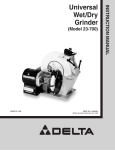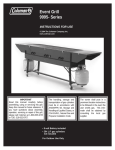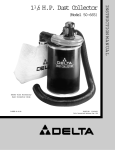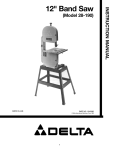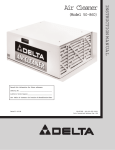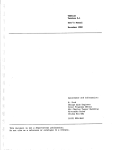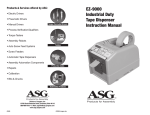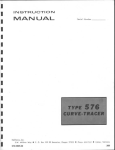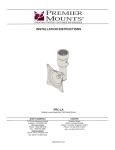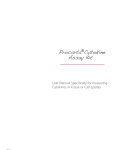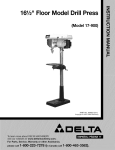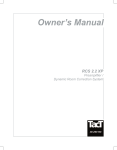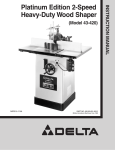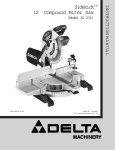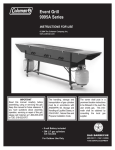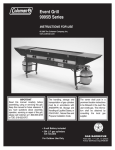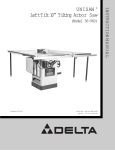Download Delta 50-840 Dust Collector User Manual
Transcript
(Model 50-840) D ATED 10-12-97 PA RT NO. 1347662 'Delta International Machinery Corp. 1997 INSTRUCTION M A N U A L One H.P.Single-Stage Dust Collector TA B L E O F C O N T E N T S SAFETY RULES ................................................................ 3 IMPORTA N T SAFETY RULES F O R D U S T COLLECTO R S .............................. 4 U N PACKING................................................................... 4 A S S E M B LY Assembling Casters To Base ................................................. 6 Assembling Support Tube And Motor And Blower Assembly To Base ............... 7 Assembling Filter And Dust Collection Bags To Drum ............................ 8 Assembling Dust Intake Hose To Motor And Blower Assembly ..................... 9 CONNECTING MACHINE TO P O W E R S O U R C E Power Connections ......................................................... 9 Motor Specifications ........................................................ 9 Grounding Instructions ...................................................... 9 120 Volt, Single Phase Operation .......................................... 10 240 Volt, Single Phase Operation .......................................... 10 Extension Cords .......................................................... 10 O P E R ATING C O N T R O L S On/Off Switch ............................................................. 11 Locking Switch In The OFF Position ........................................ 11 MAINTENANCE Motor Maintenance ........................................................ 11 W A R R A N T Y .................................................................. 12 2 IMPORTANT SAFETY RULES W oodworking can be dangerous if safe and proper operating procedures are not followed. As with all machinery, there are certain hazards involved with the operation of the product. Using the machine with respect and caution will considerably lessen the possibility of personal injury. However, if normal safety precautions are overlooked or ignored, personal injury to the operator may result. Safety equipment such as guards, push sticks, hold-downs, featherboards, goggles, dust masks and hearing protection can reduce your potential for injury.But even the best guard won t make up for poor judgment, carelessness or inattention. Always use common sense and exercise caution in the workshop. If a procedure feels dangerous, don t try it. Figure out an alternative procedure that feels safer. REMEMBER: Your personal safety is your responsibility. This machine was designed for certain applications only. Delta Machinery strongly recommends that this machine not be modified and/or used for any application other than that for which it was designed. If you have any questions relative to a particular application, DO N O T use the machine until you have first contacted Delta to determine if it can or should be performed on the product. D E LTA INTERNATIONAL MACHINERY C O R P. M A N A G E R O F TECHNICAL S E RVICES 246 A L P H A DRIVE PITTSBURGH, PENNSYLVANIA 15238 (IN CANADA: 644 IMPERIAL ROAD, GUELPH, ONTARIO N1H 6M7) W ARNING: FAILURE TO F O L L O W THESE RULES M AY RESULT IN SERIOUS P E R S O N A L INJURY 15. DON T O V E R R E A C H. Keep proper footing and balance at all times. 1. F O R Y O U R O W N S A F E T Y, READ INSTRUCTION M A N U A L B E F O R E O P E R ATING T H E TO O L. Learn the tool s application and limitations as well as the specific hazards peculiar to it. 16. MAINTAIN TO O L S IN TO P CONDITION. Keep tools sharp and clean for best and safest performance. Follow instructions for lubricating and changing accessories. 2. K E E P G U A R D S IN PLACE and in working order. 3. A LW AY S W E A R E Y E PROTECTION. 17. DISCONNECT TO O L S before servicing and when changing accessories such as blades, bits, cutters, etc. 4. G R O U N D ALL TO O L S. If tool is equipped with threeprong plug, it should be plugged into a three-hole electrical receptacle. If an adapter is used to accommodate a twoprong receptacle, the adapter lug must be attached to a known ground. Never remove the third prong. 18. U S E R E C O M M E N D E D ACCESSORIES. The use of accessories and attachments not recommended by Delta may cause hazards or risk of injury to persons. 19. R E D U C E T H E RISK O F UNINTENTIONAL S TA R TING. Make sure switch is in OFF position before plugging in power cord. 5. R E M O V E ADJUSTING KEYS A N D W R E N C H E S. Form habit of checking to see that keys and adjusting wrenches are removed from tool before turning it on. 20. N E V E R STA N D O N TO O L. Serious injury could occur if the tool is tipped or if the cutting tool is accidentally contacted. 6. K E E P W O R K A R E A C L E A N. Cluttered areas and benches invite accidents. 7. DON T U S E IN D A N G E R O U S ENVIRONMENT. Don t use power tools in damp or wet locations, or expose them to rain. Keep work area well-lighted. 21. C H E C K D A M A G E D PA R T S. Before further use of the tool, a guard or other part that is damaged should be carefully checked to ensure that it will operate properly and perform its intended function check for alignment of moving parts, binding of moving parts, breakage of parts, mounting, and any other conditions that may affect its operation. A guard or other part that is damaged should be properly repaired or replaced. 8. K E E P CHILDREN A N D VISITO R S AW AY. All children and visitors should be kept a safe distance from work area. 9. M A K E W O R K S H O P CHILDPROOF with padlocks, master switches, or by removing starter keys. 10. DON T FORCE TO O L. It will do the job better and be safer at the rate for which it was designed. 22. DIRECTION O F FEED.Feed work into a blade or cutter against the direction of rotation of the blade or cutter only. 11. U S E RIGHT TO O L. Don t force tool or attachment to do a job for which it was not designed. 23. N E V E R L E AV E TO O L RUNNING UNATTENDED. TURN P O W E R O F F. Don t leave tool until it comes to a complete stop. 12. W E A R P R O P E R A P PA R E L. No loose clothing, gloves, neckties, rings, bracelets, or other jewelry to get caught in moving parts. Nonslip footwear is recommended. Wear protective hair covering to contain long hair. 24. DRUGS, ALCOHOL, MEDICATION. Do not operate tool while under the influence of drugs, alcohol or any medication. 13. A LW AY S U S E SAFETY GLASSES.W ear safety glasses. Everyday eyeglasses only have impact resistant lenses; they are not safety glasses. Also use face or dust mask if cutting operation is dusty. 25. M A K E S U R E TO O L IS DISCONNECTED FROM POWER SUPPLY while motor is being mounted, connected or reconnected. 14. S E C U R E W O R K. Use clamps or a vise to hold work when practical. It s safer than using your hand and frees both hands to operate tool. 26. W ARNING: The dust generated by certain woods and wood products can be injurious to your health. Always operate machinery in well ventilated areas and provide for proper dust removal. Use wood dust collection systems whenever possible. 3 IMPORTA N T SAFETY RULES F O R D U S T COLLECTO R S 10. D O N O T pull the dust collector by the power cord. NEVER allow the power cord to come in contact with sharp edges, hot surfaces, oil or grease. W ARNING: Basic precautions should always be followed when using your dust collector. To reduce the risk of injury, electrical shock or fire, comply with the safety rules listed below: 11. D O N O T unplug the dust collector by pulling on the power cord. A LW AY S grasp the plug, not the cord. 1. R E A D and understand the instruction manual before operating the dust collector. 12. D O N O T handle the plug or dust collector with wet hands. 2. D O N O T leave the dust collector plugged into the electrical outlet. Unplug dust collector from the outlet when not in use and before servicing, changing bags, unclogging and cleaning. 13. REPLACE a damaged cord immediately.D O N O T use a damaged cord or plug. If the dust collector is not operating properly, or has been damaged, left outdoors or has been in contact with water, return it to an Authorized Service Center for service. 3. A LW AY S turn the power switch OFF before unplugging the dust collector. 14. D O N O T use the dust collector as a toy. D O N O T use near or around children. 4. W ARNING: TO R E D U C E T H E RISK O F ELECTRICAL S H O C K, do not use outdoors or on wet surfaces. Use for dry pickup only! 15. D O N O T insert fingers or foreign objects into the dust intake ports. Keep hair, loose clothing, fingers, and all body parts away from openings and moving parts of the dust collector. 5. F O L L O W all electrical and safety codes, including the National Electric Code (NEC) and the Occupational Safety and Health Regulations (OSHA). All electrical connections and wiring should be made by qualified personnel only. 16. D O N O T use the dust collector without the filter bag and dust collection bag in place and properly secured. 6. D O N O T use the dust collector to pick up flammable or combustible liquids, such as gasoline. N E V E R use the dust collector near any flammable or combustible liquids. 17. D O N O T operate the dust collector with unused dust intake ports uncapped. A LW AY S cover exposed dust intake ports. 7. U S E the dust collector to pick up wood materials only. D O N O T use the dust collector to pick up metal shavings, dust, or parts. 18. PERIODICALLY INSPECT dust and filter bags for any cuts,rips or tears. NEVER operate the dust collector with a damaged bag or vacuum hose. 8. NEVER use the dust collector to dissipate fumes or smoke. N E V E R pick up anything that is burning or smoking, such as cigarettes, matches or hot ashes. 19. The dust collector is designed for home use or light commercial duty O N LY! 20. C O N N E C T dust collector to a properly grounded outlet only. See grounding instructions. 9. U S E only as described in this manual. U S E only accessories recommended by Delta. S AV E THESE INSTRUCTIONS U N PACKING Carefully unpack the dust collector from the shipping container. W ARNING: D O N O T C O N N E C T T H E D U S T C O L L E C TO R TO T H E P O W E R S O U R C E UNTIL T H E M A C H I N E IS C O M P L E T E LY A S S E M B L E D A N D Y O U H AV E R E A D A N D U N D E R S TA N D T H E ENTIRE OWNER S M A N U AL. Figures 2 illustrates the components after they are removed from the shipping container. 4 U N PACKING 14 15 13 1 12 11 10 5 9 2 8 7 4 3 6 Fig. 2 1 -Motor and Blower assembly 8 -5/16-18 x 1/2 hex head screws for mounting motor and blower assembly to base (4) 2 -Base 9 -Dust collection bag 3 -Casters (4) 10 -Dust collection and filter bag clamps (2) 4 -10-24 x 3/8 pan head screws (16) 11 -Filter bag 5 -5/16-18 hex nut, lockwasher and flat washer for mounting filter bag support rod 12 -Hose clamps (2) 6 -Open-end wrench 13 -Filter bag support rod 7 -1/4-20 x 1/2 hex head screws for mounting support tube to motor and blower assembly (3) 14 -Support tube 15 -Dust intake hose 5 A S S E M B LY ASSEMBLING CASTERS TO B A S E Turn base (A) Fig. 3, over.Align four holes (B) in caster with holes at the corner of the base and assemble caster (C) to base with four pan head screws (D). Assemble the remaining three casters (C) Fig. 4, to the base in the same manner. B A C D Fig. 3 C C Fig. 4 6 ASSEMBLING SUPPORT TUBE A N D M O TO R A N D B L O W E R A S S E M B LY TO BASE B A C 1. Place the motor and blower assembly (A) Fig. 5, upside down on a sturdy supporting surface. Fig. 5 2. Find the support tube (B) Fig. 5, and three 1/2 inchlong hex head screws (C). B 3. Carefully place support tube (B) Fig. 6, over the motor impellers (D). Align three holes (E) Fig. 6, in support tube (B) with three holes in the motor casting, two of which are shown at (F) and fasten support tube (B) to motor and blower assembly (A) with three 1/2 inch-long screws (C) Fig. 7. Warning label (K) Fig. 7, should be positioned over the on/off switch (L) when support tube (B) is properly positioned as shown. NOTE: Do not tighten three screws, two of which are shown at (C) Fig. 8, at this time. E D F E A F 4. Carefully turn motor and blower assembly (A) Fig. 8, with support tube (B) attached, right side up. Align the four holes in the feet of support tube (B) Fig. 8, with four threaded holes (K) in base and fasten motor and blower assembly (A) Fig. 9, to base (L) with four 5/16-18 x 1/2 hex head screws, three of which are shown at (M). Fig. 6 B 5. IMPORTA N T:Make certain motor and blower assembly (A) Fig. 9, is parallel with base (L). If adjustment is necessary, rotate motor (N) on support tube (B) and tighten three mounting screws, one of which is shown at (C). C K L Fig. 7 N C A L M A K M B L K K B Fig. 8 Fig. 9 7 ASSEMBLING FILTER A N D D U S T COLLECTION B A G S TO D R U M E 1. Thread 5/16 hex locknut (A) Fig. 10, onto the end of bag support rod (B). Place lockwasher and flat washer (C) Fig. 10, onto bag support rod (B). Thread rod into hole (D) and tighten locknut (A) against motor and blower assembly (E) to hold support rod (B) upright. Height of support rod can be adjusted after the filter bag is in place. A B D C Fig. 10 B F H 2. Hook the loop on the top of filter bag (F) Fig. 11, onto the end of support rod (B). 3. Position open end of filter bag (F) Fig. 11, over the lip of drum (G). NOTE: It may be necessary to adjust the height of the drum support rod at this time. If adjustment is necessary, loosen locknut (A) Fig. 11, and rotate support rod (B) as needed to obtain proper rod height to support filter bag (F). Tighten locknut (A) Fig. 11. Insert locking band (H) through the hem of filter bag (F) and fasten filter bag to drum by locking clamp (J) as shown in Fig. 12. IMPORTA N T:Make certain band (H) is positioned in the channel of drum (G) before locking clamp (J). G A Fig. 11 H J G Fig. 12 4. Insert remaining locking band (H) Fig. 13, through hem of dust collection bag (K). Position open end of bag over the lip of drum (G) and fasten with locking clamp (J). NOTE: Make certain locking band (H) is positioned in the channel of drum before locking clamp (J). G J H K Fig. 13 8 A C ASSEMBLING D U S T INTA K E H O S E TO M O TO R A N D B L O W E R A S S E M B LY The dust collector is supplied with a 4 intake hose. B flexible dust To assemble the dust collection hose to the motor and blower assembly, loosely attach hose clamp (A) Fig. 14, around one end of flexible hose (B) and assemble the hose to dust intake port (C). Tighten hose clamp (A) Fig. 15, to hold flexible hose (B) on the blower and motor assembly (D). Assemble the remaining clamp to the other end of the flexible hose and to the woodworking machine. IMPORTA N T:Do not operate the dust collector without the flexible hose assembled to the dust intake port. Fig. 14 A B Always disconnect dust collector from the power source before connecting or disconnecting an air intake hose to or from the blower and motor assembly. D Fig. 15 CONNECTING MACHINE TO POWER SOURCE POWER CONNECTIONS A separate electrical circuit should be used for your tools. This circuit should not be less than #12 AWG and should be protected with a 20 amp, time lag fuse. Have a certified electrician repair or replace damaged or worn cord immediately.Before connecting the motor to the power line, make certain the switch is in the OFF position and be sure that the electric current is of the same characteristics as stamped on the motor nameplate. All line connections should make good contact. Running on low voltage will damage the motor. W ARNING: D O N O T EXPOSE THE DUST COLLECTO R TO RAIN O R O P E R ATE THE MACHINE IN DAMP L O C ATIONS. M O TO R SPECIFICATIONS The motor of the Model 50-840 Dust Collector is shipped wired for 120 Volts. Before connecting the dust collector to the power source, make certain the switch is in the OFF position. G R O U N D I N G INSTRUCTIONS W ARNING: THIS TO O L M U S T B E G R O U N D E D WHILE IN U S E TO P R O T E C T T H E O P E R ATO R F R O M ELECTRIC SHOCK. This dust collector must be grounded. If it should malfunction or break down, grounding provides a path of least resistance for electric current to reduce the risk of electric shock. This dust collector is equipped with a cord having an equipment-grounding conductor and grounding plug. The plug must be inserted into an appropriate outlet that is properly installed and grounded in accordance with all local codes and ordinances. W ARNING: Improper connection of the equipment-grounding conductor can result in a risk of electric shock. Check with a qualified electrician or service person if you are in doubt as to whether the outlet is properly grounded. Do not modify the plug provided with the dust collector. If it will not fit the outlet, have a proper outlet installed by a qualified electrician. 9 120 VOLT, SINGLE P H A S E O P E R ATION GROUNDED OUTLET B O X This tool must be grounded while in use to protect the operator from electric shock. The motor recommended for use with your dust collector is shipped wired for 120 Volt, Single Phase, and is equipped with an approved 3-conductor cord and 3-prong grounding type plug to fit the proper grounding type receptacle, as shown in Fig. 16. The green conductor in the cord is the grounding wire. Never connect the green wire to a live terminal. CURRENT C A R RYING PRONGS GROUNDING BLADE IS LONGEST O F THE 3 BLADES A temporary adapter, shown in Fig. 17, is available for connecting 3-prong grounding type plugs to 2-prong receptacles if a properly grounded outlet is not available. The temporary adapter should be used only until a properly grounded outlet can be installed by a qualified electrician. THIS A D A P T E R IS N O T APPLICABLE IN CANADA. The green-colored rigid ear, lug, etc., extending from the adapter, is the grounding means and must be connected to a permanent ground such as to a properly grounded outlet box, as shown in Fig. 17. Whenever the adapter is used, it must be held in place with a metal screw. Fig. 16 GROUNDED OUTLET B O X GROUNDING M E A N S ADAPTER 240 VOLT, SINGLE P H A S E O P E R ATION Fig. 17 The motor supplied with your dust collector is a dual voltage 120/240 volt motor.The dust collector motor is shipped ready-to-run for 120 volt operation; however, it may be converted for 240 volt operation. C U R R E N T C A R RYING PRONGS The conversion of your dust collector for 240 volt operation must be done by qualified electrical personnel. Should you desire to have your dust collector converted for 240 volts, take your dust collector to your local Authorized Delta Service Center. Call 1-800-438-2486 for the location of the nearest Authorized Service Center.The Service Center will be able to convert your dust collector for 240 volts by (a) re-wiring the motor for 240 volts; (b) installing a 240 volt attachment plug to the power supply cord; and (c) replacing the single pole on/off switch shipped with your dust collector with a double pole switch. 240 VOLT GROUND PRONG Fig. 18 The dust collector with a 240 volt plug should only be connected to an outlet having the same configuration as the plug illustrated in Fig. 18. No adapter is available or should be used with the 240 volt plug. A S A PRECAUTION IN ALL CASES, MAKE C E R TAIN T H E R E C E P TA C L E IN Q U E S T I O N IS P R O P E R LY GROUNDED. IF Y O U A R E N O T SURE, HAV E A CERTIFIED ELECTRICIAN C H E C K THE RECEPTACLE. EXTENSION CORDS TO TA L LENGTH O F C O R D IN FEET Use proper extension cords. Make sure your extension cord is in good condition and is a 3-wire extension cord which has a 3-prong grounding type plug and a 3-hole receptacle which will accept the tool s plug. When using an extension cord, be sure to use one heavy enough to carry the current of the dust collector.An undersized cord will cause a drop in line voltage resulting in loss of power and overheating. Fig. 19, shows the correct size to use depending on cord length and voltage. If in doubt, use the next heavier gage. The smaller the gage number, the heavier the cord. 120 VOLT 25 50 100 150 G A G E O F EXTENSION C O R D TO U S E 240 VOLT 50 100 200 300 Fig. 19 10 18 16 14 12 AW AW AW AW G G G G O P E R ATING C O N T R O L S F O R O P E R ATO R SAFETY, BEFORE O P E R ATING THE MACHINE, MAKE CERTAIN T H AT THE D U S T INTA K E H O S E IS A LW AY S ATTA C H E D TO T H E D U S T INTA K E P O R T.T H E R O TATING FA N L O C ATED INSIDE THE B L O W E R HOUSING IS ACCESSIBLE T H R O U G H THE DUST INTA K E P O R T A N D C A N B E HAZARDOUS. A LW AY S W E A R P R O P E R A P PAREL. DO NOT WEAR J E W E L RY A N D K E E P FINGERS A N D ALL FOREIGN OBJECTS O U T O F THE DUST INTA K E P O R T.F O L L O W THE SAFETY RULES EARLIER IN THIS MANUAL. ON/OFF SWITCH The on/off switch is located on the side of the motor. To turn the dust collector ON, push switch toggle (A) Fig. 20, upward. To turn the dust collector OFF, push switch toggle (A) downward. A Fig. 20 LOCKING SWITCH IN T HE OFF POSITION W e suggest that when the dust collector is not in use, that the switch (B) be locked in the OFF position. This can be done by grasping the switch toggle (A) Fig. 21, and pulling it out of the switch (B) as shown. With the switch toggle (A) Fig. 21, removed, the switch will not operate. However, should the switch toggle (A) be removed while the dust collector is running, it can be turned OFF once, but cannot be restarted without inserting the switch toggle. B A Fig. 21 MAINTENANCE NOTE: Before any maintenance or service is performed, be sure the unit is disconnected from the power source to prevent accidental starting. All servicing other than the items recommended in this Instruction Manual should be performed by an authorized service facility. When storing your dust collector, remove power supply cord from the electrical outlet. Coil the cord neatly and place it off the floor on the base of the dust collector to eliminate potential cord damage. M O TO R MAINTENANCE Removing dust and dirt: Blow off motor with low pressure air to remove dust or dirt. Air pressure above 50 P.S.I. should not be used as high pressure may damage insulation and blow dirt under loosened tape. The operator peforming this cleaning function should always wear eye protective goggles. Dust can cause excessive insulation temperatures. 11 Delta Building Trades and Home Shop Machinery Two Year Limited Warranty Delta will repair or replace, at its expense and at its option, any Delta machine, machine part, or machine accessory which in normal use has proven to be defective in workmanship or material, provided that the customer returns the product prepaid to a Delta factory service center or authorized service station with proof of purchase of the product within two years and provides Delta with reasonable opportunity to verify the alleged defect by inspection. Delta may require that electric motors be returned prepaid to a motor manufacturer s authorized station for inspection and repair or replacement. Delta will not be responsible for any asserted defect which has resulted from normal wear, misuse, abuse or repair or alteration made or specifically authorized by anyone other than an authorized Delta Service facility or representative. Under no circumstances will Delta be liable for incidental or consequential damages resulting from defective products. This warranty is Delta s sole warranty and sets forth the customer s exclusive remedy, with respect to defective products; all other warranties, express or implied, whether of merchantability, fitness for purpose, or otherwise, are expressly disclaimed by Delta. Printed in U.S.A. 12












